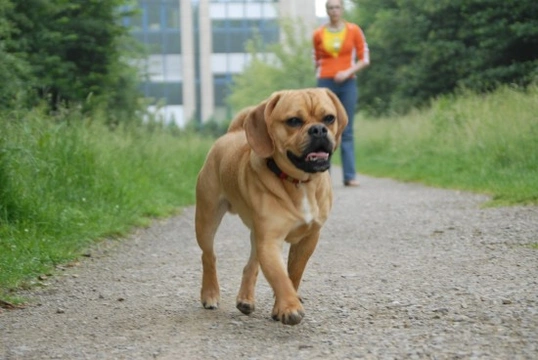
Potential problems with the puggle dog
The puggle is a cross breed or hybrid breed of dog that is created from the crossing of a pug with a beagle, or any second generation or subsequent crossing of puggles with each other or back to one of the parent breeds. While they are not classed as a pedigree dog breed in their own right, hybrid breeds of various types are very popular today, and the puggle is one of the most popular of them all, combining all of the best traits of the two component breeds while going some way to improve the health of the pups thanks to their hybrid vigour.
The puggle can stand between 8-15” tall at the withers, and weigh from 15-30lb, with quite a lot of variance being possible due to the differences between the two component breeds, and the fact that crossing two breeds can provide a lot of variance in the traits of the resultant litters.
While the puggle is a good choice of pet with a lot of positive features, this particular hybrid cross also potentially has a few downsides to it as well, which all potential buyers and owners should be aware of. Read on to learn more about some of the potential problems and downsides that can occur with the puggle dog.
Coat shedding
Both the pug and the beagle are shorthaired dogs with single layered coats, which has the advantage of making the puggle very low maintenance when it comes to coat care. They don’t really need brushing, and only the occasional bath when they get pongy will be sufficient to keep them in good condition.
However, despite their short, close cropped fur, the puggle tends to be a heavy hair shedder, particularly around the changes of the seasons. This means that your home and furniture is apt to get covered in hair, and you will need to invest in a good, powerful vacuum cleaner and possibly a slicker brush to clear up all of the shed hair!
Sensitivity to heat
The pug breed is brachycephalic, which means that they have very short, squashed muzzles. How pronounced this trait is within any puggle can vary considerably, with some puggles having the long muzzle of the beagle, while others have a short muzzle like that of the pug. Short muzzled puggles are likely to have problems staying cool enough in hot weather, and special care should be taken with dogs of the breed to ensure that they drink enough water, can find a cool, shaded spot, and do not overheat.
Breathing issues
One of the main benefits of breeding the puggle over the pug is that the flatness of the face will be less pronounced within the puggle, but even so, their faces can still be very short and flat. Like the difficulty in maintaining a cool enough temperature in hot weather, this trait can cause some other issues for short muzzled dogs too.
Dogs with short, brachycephalic muzzles may suffer from a spectrum of problems, with snoring being among the most common, and laboured, wheezy or noisy breathing may also occur when the dog is awake.
They may also suffer from reverse sneezing, tracheal collapse, protruding eyes, and a range of other problems too. An added problem that arises due to these traits within the puggle is the fact that the beagle side of their lineage often produces a very lively, excitable and fun loving dog, which is apt to want to do more and push themselves further than their lung capacity and ability to breathe normally will allow for.
Noise levels
The pug is not renowned for being one of the loudest of all dog breeds, but they do bark on occasion, in play and excitement or to get your attention. The beagle, however, is one of the most vocal of dogs, with a wide repertoire of sounds that they are not afraid to use, including excessive barking, and a propensity to howl. Exactly how loud any given puggle will be can vary considerably, but the potential to being loud, talkative and prone to making a lot of noise is something that every puggle owner should be aware of.
Skin problems
Puggles with wrinkled faces of the pug type require their skin folds to be cleaned and dried thoroughly on a daily basis, in order to avoid the formation of sores and the development of infections. If this is not performed for short muzzled dogs, the puggle may develop skin problems, due to the creased skin present on the face.
Pugs are also a breed of dog that is apt to suffer from skin sensitivities and allergies on occasion, and if your puggle is unlucky enough to inherit this trait from their pug side, it can mean that keeping your dog from itching themselves to distraction, and keeping them clear of allergens, can be a challenge.



